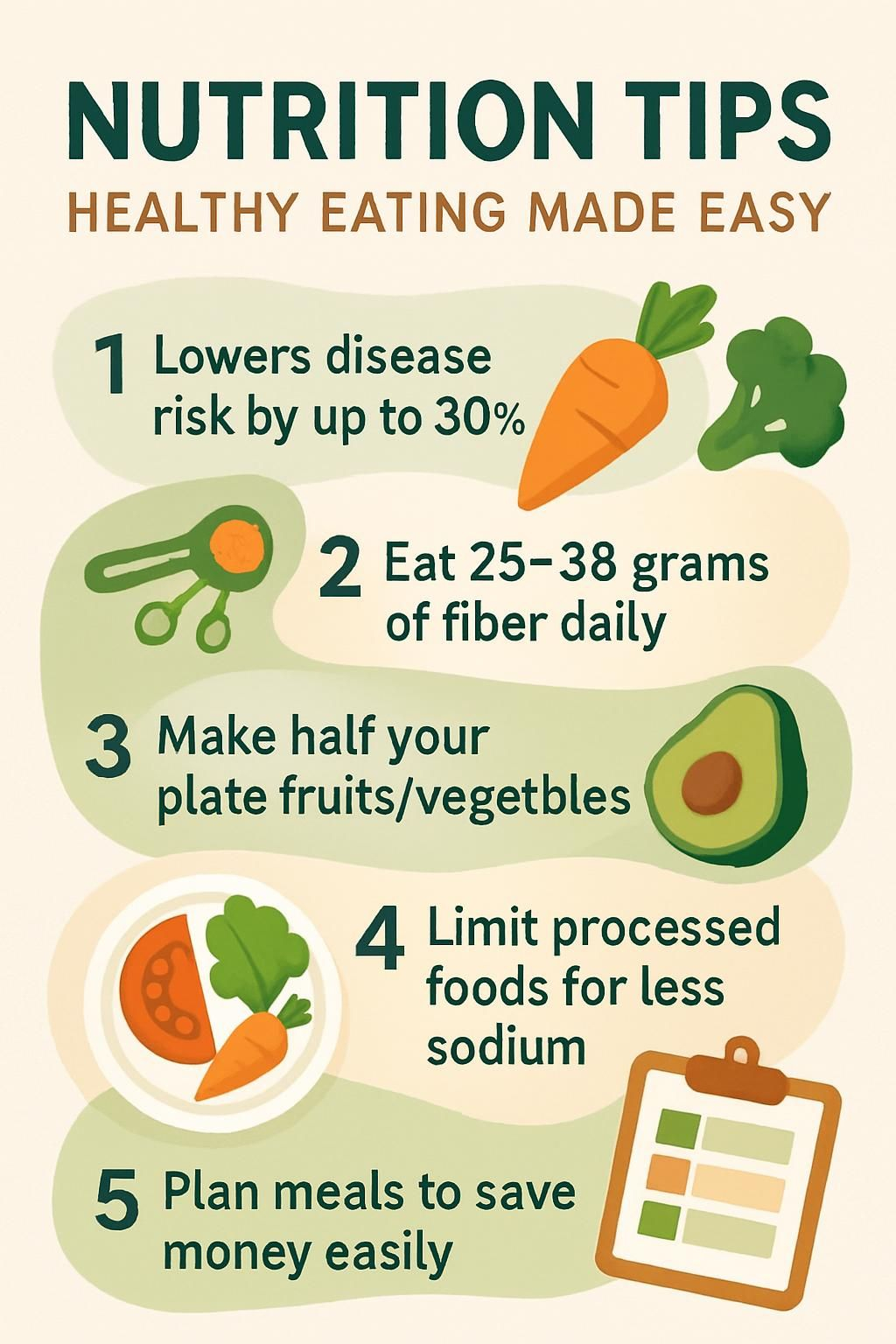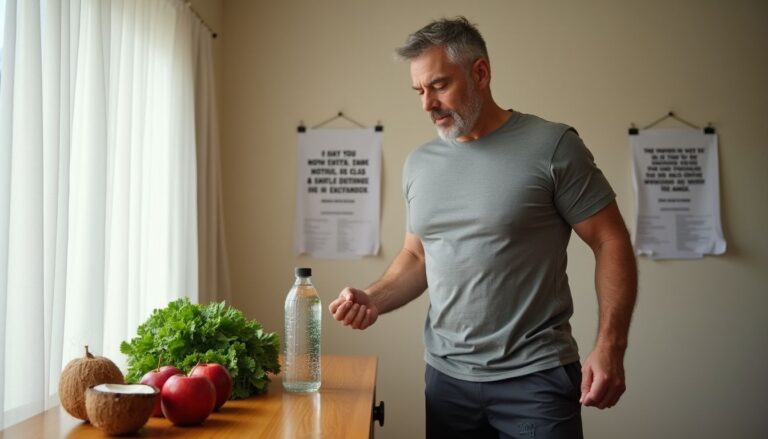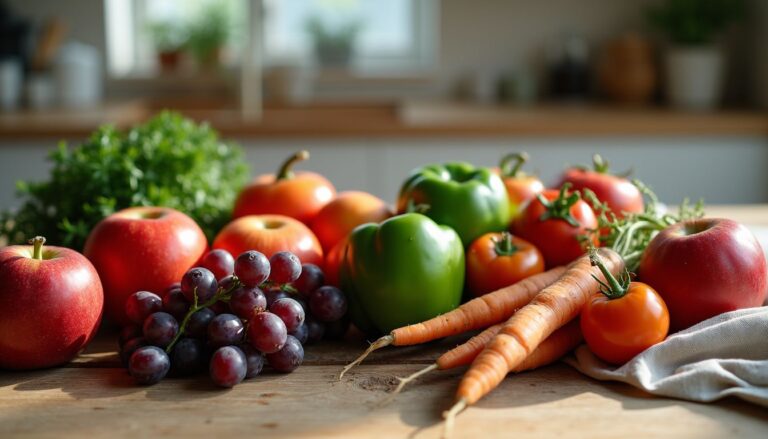Nutrition Tips: Healthy Eating Made Easy
Our Nutrition Assistant AI Suite will transform your body. You will lose fat, get toned, and build muscle. Gain confidence and optimal health.
Sorting healthy eating advice can feel confusing. Simple nutrition tips make it easier to choose foods that support your body and mind. Research shows that following healthy eating habits lowers the risk of heart disease, diabetes, and obesity.
This guide gives you clear steps to eat more fruits and vegetables, build better meals, and form lasting habits. The ideas below fit busy lives and tight budgets. Use what works for you and add one change at a time.
Key Takeaways
- Healthy eating can reduce the risk of heart disease, type 2 diabetes, and some cancers by up to 30%, according to the CDC.
- MyPlate suggests making half your plate fruits and vegetables and choosing whole grains for more fiber and stable energy.
- Most adults need 25 to 38 grams of fiber per day, lean proteins such as fish or beans, and healthy fats like olive oil.
- About 70% of sodium comes from processed foods, and avoiding trans fats supports healthier cholesterol levels, per the FDA.
- Planning meals, buying in bulk, and choosing seasonal or frozen produce can save money while meeting nutrient needs.

Why is Healthy Eating Important?

Food is your daily fuel. Eating well helps you feel alert, move with energy, and keep a healthy weight.
What Are the Physical Health Benefits of Healthy Eating?
A balanced diet helps with weight control, which lowers the risk of type 2 diabetes and heart disease. Meals built with fruits, vegetables, whole grains, lean meats like poultry and fish, and low-fat or fat-free dairy can reduce high blood pressure and support bone strength.
Dietary fiber helps digestion and prevents constipation. Choosing fewer foods high in saturated fat, trans fats, added sugar, and extra salt supports heart health and better cholesterol levels. After I added more vegetables and whole grains to lunch, my exercise sessions felt easier and my energy lasted longer.
How Does Healthy Eating Affect Mental Well-being?
Nutritious foods support brain function and mood. Omega-3 fats, found in oily fish and some nuts, help the brain and may reduce depression risk. People who eat more fruits, vegetables, whole grains, and legumes often report less anxiety than those who rely on heavily processed foods and sugary drinks.
Balanced meals stabilize blood sugar levels throughout the day. Big spikes from sweet drinks can lead to irritability and fatigue. Foods with protein, such as beans, yogurt, cheese, and seeds, help steady energy for school or work. When I swapped a pastry for oatmeal with fruit, my focus improved through long meetings.
How Does Healthy Eating Help Prevent Diseases?
Eating fruits, vegetables, whole grains, and lean proteins strengthens your immune system and lowers the risk of chronic disease. Plant-forward meals with beans, peas, carrots, lentils, broccoli, brown rice, olive oil, and leafy greens can reduce heart disease risk by improving cholesterol and blood pressure.
The Dietary Guidelines for Americans suggest filling half your plate with fruits and vegetables to cover many vitamin and mineral needs. Limiting saturated fat from butter and processed meats protects your heart, and using unsaturated fats, such as olive or canola oil, supports healthy arteries.
People who follow a healthy eating pattern show up to 25% lower rates of cardiovascular disease and 30% lower risk for certain cancers, including colorectal cancer. I noticed more daily energy after replacing soda with water and adding bean salads at lunch. Managing weight through smart food choices also cuts the risk of diabetes and hypertension.
…
[1]: Centers for Disease Control (CDC), “Benefits of Healthy Eating,” cdc.gov/nutrition/resources-publications/benefits-of-healthy-eating.html
How to Build a Balanced Diet
Variety is the goal. Following MyPlate helps you design meals that supply what your body needs, from vitamins to protein to fiber.
How Can I Include More Fruits and Vegetables in My Diet?
Fruits and vegetables protect your health and support your immune system. Small daily changes add up fast.
- Start breakfast with fresh fruit on cereal, oatmeal, or yogurt. Strawberries, bananas, and blueberries add color and nutrients.
- Pack sliced vegetables, such as carrots, cucumbers, or bell peppers, for snacks. They are portable and filling with few calories.
- Use vegetables as toppings for sandwiches, pizza, and pasta. Tomatoes, spinach, and avocado boost flavor and nutrition.
- Include at least one fruit or vegetable in every meal and snack. MyPlate advises making half your plate produce.
- Buy seasonal produce to get different colors and tastes. This helps you cover many vitamins and minerals.
- Choose canned or frozen options with no syrup or sauces. They are budget friendly and keep nutrients well.
- Add vegetables to soups, stews, and sauces for extra fiber. Cauliflower, carrots, and tomatoes blend into many dishes.
- Blend leafy greens like spinach or kale into smoothies. Milk or juice softens the taste while adding calcium or vitamin C.
- Swap processed snacks for fruit or a small handful of nuts. This supports heart health and reduces added sugar.
- Try new recipes that make vegetables the star. Roast, grill, or steam to keep flavor and nutrients.
Why Choose Whole Grains Over Refined Grains?
Whole grains keep the bran and germ, which supply fiber, vitamins, and minerals. Options like brown rice, oatmeal, whole wheat bread, and corn provide B vitamins, magnesium, and antioxidants.
People who eat more whole grains have a lower risk of heart disease and type 2 diabetes. Natural fiber slows digestion and helps you feel full longer. After switching from white bread to oats and whole wheat pasta, my energy felt steadier through the afternoon.
The typical American diet includes many refined products that lack key nutrients. Pair fruits and vegetables with whole grains to build stronger meals.
What Are Good Sources of Lean Proteins and Healthy Fats?
Chicken breast, turkey, eggs, and fish like salmon or tuna deliver lean protein for muscle repair. Greek yogurt, cottage cheese, tofu, beans, and lentils also provide protein with less saturated fat.
Nuts such as almonds and walnuts add plant protein and important minerals. Healthy fats from avocados, olive oil, chia seeds, flaxseeds, and fatty fish support brain and heart health. Try olive oil instead of butter. Snack on a small handful of nuts instead of chips. I now top whole grain toast with avocado, which keeps my energy steady.
Essential Nutrition Tips for Daily Life
Daily habits make the difference. Small, steady steps help you stick with good nutrition tips long term.
How Can I Diversify My Food Choices?
Eating a range of foods supplies more nutrients and may lower cancer risk. Variety also keeps meals interesting.
- Eat the rainbow. Each color of fruits and vegetables offers different antioxidants and vitamins.
- Explore whole grains like quinoa, brown rice, barley, and whole wheat bread instead of white rice or fries.
- Rotate proteins. Lean meats, fish, eggs, beans, and lentils give different amino acids and minerals.
- Use both saturated and unsaturated fats in moderation. Prefer olive or canola oil instead of butter or lard.
- Flavor food with herbs and spices rather than salt. Basil, rosemary, paprika, and cilantro add bold taste.
- Include dairy or calcium-rich foods like yogurt, cheese, or fortified plant milk to meet calcium and vitamin D needs.
- Sweeten with fruit. Fresh fruit or a touch of honey can reduce added sugar in drinks and snacks.
- Rely on frozen or canned produce if needed. These are budget friendly and keep nutrients well.
- Read the Nutrition Facts label on packaged foods. Watch for added sugars, sodium, and types of fat.
- Try international dishes that highlight new grains, spices, and cooking styles to expand your menu.
- Plan weekly variety. Add a new vegetable, grain, or bean to prevent boredom.
Why Should I Minimize Processed and Packaged Foods?
Processed foods often contain high amounts of added sugar, sodium, and unhealthy fats. These raise the risk of weight gain, high blood pressure, and heart disease.
The CDC reports that about 70% of sodium comes from packaged products. Fresh fruits, vegetables, and lean proteins usually offer more vitamins and minerals with fewer additives. I replaced a daily soft drink with water and felt more alert throughout the day. Choosing nuts or fruit over packaged snacks kept me full and supported my weight goals.
What Are Natural Sweeteners and Why Prefer Them Over Added Sugars?
Reducing added sugar helps control energy dips and supports heart health. Natural sweeteners, such as honey, maple syrup, and fruit purees, add sweetness plus some nutrients. For example, mashed bananas in oatmeal add potassium, fiber, and vitamins.
Added sugars in soda and desserts lead to blood sugar spikes and extra calories. Using natural sweeteners in small amounts may reduce the risk of type 2 diabetes. Whole fruit or a spoon of honey in plain yogurt can satisfy a sweet tooth without relying on highly processed sugar.
How Can I Manage Portion Sizes Effectively?
Managing portions helps prevent overeating and supports weight goals. Simple tools make it easier.
- Use smaller plates and bowls. This makes portions look larger and discourages second helpings.
- Check serving sizes on labels. Many packages contain more than one serving.
- Fill half your plate with fruits and vegetables. This reduces room for high-calorie items.
- Measure calorie-dense foods with cups or a scale. You will learn what a real serving looks like.
- Avoid eating from large bags or cartons. Place snacks on a plate so you can see the amount.
- Pay attention to hunger and fullness cues. Stop when you feel satisfied, not stuffed.
- Build meals with lean protein, whole grains, and healthy fats to stay full longer.
- Limit restaurant meals. Share a dish or request a to-go box before you start eating.
- Drink water before and during meals. It helps control appetite and replaces sugary drinks.
- I once kept a food diary for a month. Seeing portions on paper helped me fix frequent overeating.
Sources:
- Centers for Disease Control and Prevention (CDC): “Healthy Eating for a Healthy Weight”
- Harvard T.H. Chan School of Public Health: “The Nutrition Source”
- American Heart Association: “Watch Your Portion Sizes”
Key Nutrients to Prioritize
Some nutrients deserve extra attention. Focusing on fiber, calcium with vitamin D, potassium, and omega-3 fats supports steady energy and strong health.
Why Is Fiber Important for Digestive and Heart Health?
Fiber keeps digestion regular and helps prevent constipation. Adults need at least 25 to 38 grams per day, yet most people get about half that amount. Fiber from fruits, vegetables, whole grains, and beans also lowers the risk of digestive issues.
Higher fiber intake is linked to lower LDL, the “bad” cholesterol. That supports heart health and may lower blood pressure. After I switched to whole grains and added beans to dinner, my digestion and energy both improved.
How Do Calcium and Vitamin D Support Bone Strength?
Calcium builds and protects bones. Vitamin D helps your body absorb calcium. Too little of either can lead to weaker bones and fractures later in life. Kids need both for proper growth.
Fish such as salmon and sardines provide protein and some vitamin D in the same meal. Fortified foods can also boost intake, which helps people who avoid dairy. Drinking milk in childhood helped me avoid frequent sports injuries in high school.
What Is the Role of Potassium in Blood Pressure Management?
Potassium balances sodium and supports healthy blood pressure. Bananas, potatoes, spinach, and beans are good sources. The American Heart Association notes that adults benefit from getting about 4,700 milligrams per day from foods.
Kidneys use potassium to remove extra sodium through urine. This eases pressure on blood vessel walls. Choose more fresh produce and fewer salty, processed foods to improve blood flow.
How Do Omega-3 Fatty Acids Benefit Brain and Heart Health?
Omega-3 fats support nerve cell function and may protect memory as you age. Kids who eat omega-3 rich foods often show better focus at school. Salmon, walnuts, and flaxseeds are reliable sources. Many clinicians suggest eating fish twice per week.
Omega-3s also support the heart by lowering blood pressure and triglycerides. Research from the American Heart Association shows people who get enough omega-3s have a lower risk of heart disease. After I added salmon twice a week, my cholesterol improved at my checkup.
Strategies to Reduce Unhealthy Additives
Cutting excess sodium, trans fats, and added sugar protects your heart and supports a healthy weight. Simple swaps make a big difference over time.
How Can I Reduce Salt and Sodium Intake?
High sodium intake raises blood pressure. These steps help you cut back without losing flavor.
- Compare labels and pick items with 140 milligrams of sodium or less per serving.
- Limit fast food, restaurant meals, canned soups, and salty snacks. Home cooking gives you control.
- Season with herbs, spices, lemon juice, or vinegar instead of salt.
- Rinse canned vegetables, beans, and fish. This can remove up to 40% of added sodium.
- Check “reduced sodium” and “low-sodium” labels, and still read the number on the panel.
- Eat more fresh fruits and vegetables, which are naturally low in sodium.
- Ask for nutrition information at restaurants and request sauces on the side.
Why Avoid Trans Fats and Limit Saturated Fats?
Focus on fat quality after tackling sodium. Trans fats raise LDL cholesterol and lower HDL cholesterol, even in small amounts. Many pastries, stick margarine, and fried snacks contain trans fats.
Limit saturated fat by choosing lean proteins like chicken or fish instead of fatty red meat. Replace butter with olive or canola oil. I switched from butter on toast to avocado, and my yearly cholesterol numbers improved.
How Can I Cut Down on Sugary Beverages and Snacks?
Reducing sugary drinks and snacks lowers empty calories and supports steadier energy. Small steps lead to lasting change.
- Trade soda for water or unsweetened tea. Hydration improves without added sugar.
- Scan labels for added sugars such as high fructose corn syrup and sucrose.
- Choose whole fruit over juice or candy. Fruit adds fiber and vitamins.
- Prep healthy snacks like nuts or sliced vegetables so choices are ready.
- Limit buying sweets. If they are not at home, they are harder to overeat.
- Flavor foods with cinnamon or vanilla. These add taste without sugar.
- Reduce sugary drinks a little each week. A refillable bottle can track progress.
- Be mindful at parties. Pick smaller dessert portions to enjoy the taste.
- Try yogurt with berries for dessert. This adds protein, probiotics, and fiber.
- Use a food diary to monitor sugar intake and spot patterns.
These steps help you lower added sugar while protecting long-term health.
How to Eat Healthy on a Budget
Smart planning stretches your food dollars. You can enjoy a healthy diet without overspending.
How Does Planning Meals and Buying in Bulk Help Save Money?
Planning and bulk buying reduce costs and wasted food. They also make healthy choices easier.
- Plan meals to avoid impulse buys that tend to be less healthy and more expensive.
- Shop with a list so you can compare prices and find discounts.
- Buy whole grains, beans, and lean proteins in bulk to lower the unit price.
- Use bulk items in several meals. Rice, oats, and beans stretch across the week.
- Plan portions to reduce waste and keep groceries within budget.
- Store bulk foods well to keep nutrients and freshness.
- Freeze extra portions for quick future meals and fewer processed options.
- Batch cooking saves time and supports healthy habits on busy days.
Why Choose Seasonal and Local Produce?
Seasonal and local produce often has more nutrients and better flavor. Shorter travel time means less nutrient loss and lower prices at peak harvest.
Buying local supports farmers and reduces the carbon footprint linked to shipping. Farmers’ markets also let you ask about storage and cooking tips.
What Are the Benefits of Using Frozen and Canned Options?
Frozen and canned produce can be just as nutritious as fresh, and often more convenient. Frozen fruits and vegetables are picked at peak ripeness, then quickly frozen to lock in vitamins.
Canned beans, vegetables, and fruits last longer and cut food waste. During college, I kept canned tomatoes and beans on hand, which made quick, healthy dinners possible. Choose reduced-sodium options when you can.
Healthy Eating Tips for Traveling
Travel can disrupt routines, but a little planning keeps nutrition on track.
What Are Nutritious Snacks to Pack When Traveling?
Smart snacks prevent energy crashes and help you avoid overpriced convenience foods.
- Pack mixed nuts and seeds. One ounce delivers protein, healthy fat, and minerals.
- Carry whole fruits like apples, oranges, or bananas for fiber and steady energy.
- Choose single-serve roasted chickpeas or edamame for a crunchy, high-fiber bite.
- Pair whole-grain crackers with nut butter for long-lasting fuel.
- Bring Greek yogurt cups or cheese sticks in a small cooler for calcium and protein.
- Cut veggie sticks such as carrots, celery, or peppers for a hydrating crunch.
- Pick dried fruit with no added sugar, like raisins or apricots, for potassium and iron.
- Use unsweetened applesauce or fruit cups packed in water for a quick sweet pick.
- Prepare simple energy bars with oats, seeds, dried fruit, and a bit of honey.
These choices keep you satisfied on the road and support your goals.
How Can I Choose Healthier Options When Dining Out?
Eating out can fit a healthy plan with a few smart moves.
- Check the menu online for grilled, baked, or steamed proteins instead of fried options.
- Add a side of vegetables or a salad with dressing on the side.
- Choose whole grains like brown rice or whole wheat bread instead of white rice or regular pasta.
- Ask for sauces and dressings on the side to control portions.
- Skip sugary drinks. Choose water, sparkling water, or unsweetened tea.
- Share large plates or request a to-go box at the start of the meal.
- Request less salt or oil during cooking.
- Select lean proteins such as grilled chicken, fish, beans, or tofu.
- Review menu nutrition labels or calorie counts where available.
- Pick fruit, yogurt, or nuts for dessert instead of cake or ice cream.
- I often order a half portion or an appetizer as my main. It helps with portions and cost.
How Do I Read Menu Labels to Make Better Choices?
Menu labels help you compare options fast and pick meals that fit your needs.
- Check calories per serving to understand the energy in each item.
- Compare sodium, aiming for less than 500 milligrams per serving when possible.
- Scan saturated fat and trans fat. Keep saturated fat low and avoid trans fat.
- Look for fiber, ideally at least 3 grams per serving.
- Target 10 to 20 grams of protein for a satisfying meal.
- Limit added sugar, especially in sauces and dressings.
- Choose whole grains like brown rice, whole wheat bread, or quinoa.
- Short ingredient lists often mean fewer additives.
- Be cautious with “light” or “low-fat” claims. Some trade fat for sugar or salt.
- Ask staff if a label term is unclear.
Why Is Staying Hydrated Important?
Water supports every cell and system. Hydration helps you stay alert, control temperature, and digest food well.
How Much Water Should I Drink Daily?
Aim for about 8 cups, or 64 ounces, per day. Needs rise with exercise, heat, or salty meals. The National Academies suggest around 3.7 liters of fluids daily for men and 2.7 liters for women from all drinks and foods.
Thirst and urine color guide you. Pale yellow usually signals good hydration. Dark yellow often means you need more fluids.
Why Reduce Sugary and Caffeinated Beverages?
Sugary drinks add many calories and raise the risk of obesity, type 2 diabetes, and tooth decay. The American Heart Association advises limiting added sugar to less than 25 grams per day for women and 36 grams for men. A single soda can exceed that limit.
Energy drinks and some sodas also pack caffeine that can disrupt sleep and raise heart rate. Water and herbal tea hydrate without extra sugar, which supports steady energy.
Meal Planning and Cooking at Home
Cooking at home gives you control over ingredients, portions, and cost. It also makes it easier to follow a balanced diet.
How Does Cooking at Home Help Control Ingredients?
Home cooking lets you choose each ingredient and skip hidden salt, sugar, and unhealthy fats. Research shows home-cooked meals often contain far less sodium than popular fast-food items.
You can also check labels for additives or allergens. I now make pasta sauce from scratch to avoid added sugars and extra salt in jarred brands. Families who cook together tend to eat more fruits and vegetables than those who rely on packaged meals.
What Are Good Ways to Flavor Food Without Salt?
Season boldly without the shaker. Herbs, spices, and acids brighten flavor while keeping sodium low.
- Use fresh or dried herbs like basil, oregano, parsley, or cilantro in salads, soups, and meats.
- Add lemon, lime, or orange juice or zest for bright, tangy flavor on vegetables and fish.
- Sprinkle spices such as black pepper, paprika, garlic powder, cumin, or chili powder for depth.
- Splash vinegars like balsamic, apple cider, or red wine on salads or roasted vegetables.
- Sauté aromatics such as onions, garlic, shallots, and ginger to build a strong base.
- Try unsalted seasoning blends for quick, consistent flavor.
- Finish with toasted seeds or nuts for crunch and a savory note.
How Can Preparing Meals Ahead Save Time and Effort?
Meal prep helps you stay consistent on busy days. It also reduces stress and food waste.
- Prep a weekly plan to avoid last-minute choices that are less nutritious.
- Batch cook larger portions and save time during the week.
- Pack lunches to control portions and build balanced meals.
- Organize and pre-chop ingredients to speed up weeknight cooking.
- Store leftovers in single-serve containers for grab-and-go options.
- Shop with a prep list to cut costs and stick to your plan.
- During a busy semester, I made a week of lunches every Sunday. It kept my goals on track.
Encouraging Healthy Eating for Family and Children
Kids learn from what they see. Creating a positive food culture at home helps the whole family.
How Can Parents Lead by Example in Healthy Eating?
Serve balanced meals and show enthusiasm for new foods. Keep fruits, vegetables, whole grains, and lean proteins visible and easy to grab.
Share simple nutrition facts with kids, like how carrots support vision or why water hydrates better than soda. Cook more meals at home and sit together at the table. Involve children in choosing colorful produce and simple kitchen tasks.
What Are Fun Ways to Make Nutritious Eating Engaging for Kids?
Make healthy food playful and hands-on. Engagement increases curiosity and intake.
- Invite kids to wash vegetables or assemble salads. They often eat what they help prepare.
- Create colorful plates with berries, carrots, and broccoli.
- Use cookie cutters to shape sandwiches, cheese, or fruit.
- Hold a taste test for new foods. Award points for trying.
- Plan themed dinners like “Rainbow Night” or “Veggie Taco Night.”
- Grow a small garden or window box. Harvesting builds interest.
- Offer healthy dips like hummus or yogurt sauces with raw vegetables.
- Let kids build parfaits with yogurt, berries, and nuts.
- Model healthy choices at the table. Kids copy what adults do.
- Let each child pick a new fruit or vegetable at the store.
My niece chose her own bell pepper at the market and enjoyed it at dinner. Small wins like this add up.
How Can Involving Children in Meal Prep Encourage Healthy Habits?
Cooking together builds skills and confidence. It also increases the chance that kids will try new foods.
- Assign age-appropriate tasks, such as washing produce or stirring ingredients.
- Talk about nutrition while you cook, using simple language.
- Let kids help choose recipes or groceries to build interest.
- Introduce new fruits, vegetables, and whole grains while preparing meals together.
- Teach safe food handling and handwashing.
- Turn cooking into a fun activity with colorful tools and simple steps.
- Praise effort to reinforce positive habits.
Debunking Common Nutrition Myths
Myths spread fast, but facts help you make better choices. Clear answers support your eating plan.
Are Carbohydrates Actually Beneficial?
Carbohydrates provide energy for daily tasks, sports, and study time. Whole grains, fruits, and vegetables also supply fiber, vitamins, and minerals. The Dietary Guidelines for Americans suggest that 45% to 65% of daily calories can come from carbohydrates.
Skipping healthy carbs can leave you tired and unfocused. Complex carbs like brown rice, oats, and beans help keep blood sugar steady and curb cravings.
Snapshot: Why Carbohydrates Matter
| Source | Benefit | Example |
|---|---|---|
| Whole grains | Fiber and steady energy | Oatmeal, brown rice |
| Fruits and vegetables | Vitamins and antioxidants | Apples, broccoli |
| Legumes | Protein plus complex carbs | Lentils, beans |
Why Are Fats Necessary in Moderation?
Fats help your body absorb vitamins A, D, E, and K. They also build cell membranes and support brain function. Keep saturated fat low and avoid trans fats to protect heart health.
Healthy fats from avocados, nuts, seeds, olive oil, and fatty fish make meals satisfying. I replaced fried snacks with a handful of almonds or avocado slices and noticed steadier afternoon energy.
Is Skipping Meals a Good Strategy for Weight Management?
Skipping meals often backfires. It can slow your metabolism and lead to overeating later. Research from the National Institutes of Health links meal skipping with blood sugar swings and stronger cravings.
Regular, balanced meals and planned snacks provide steady energy and help control appetite. Many people find consistent eating patterns easier to maintain.
How to Monitor Your Nutritional Progress
Tracking builds awareness and keeps goals realistic. Simple tools help you adjust without guesswork.
How Can Keeping a Food Diary Help?
Writing down meals and drinks shows patterns you might miss. People who use food diaries often lose more weight than those who do not track. A notebook or app works well for logging foods and portion sizes.
In my routine, logging meals made hidden sugars and extra portions easy to spot. Sharing your diary with a clinician or dietitian can lead to more personalized guidance.
Why Is It Important to Observe Portion Sizes and Caloric Intake?
Portion sizes have grown in recent decades, which increases daily calorie intake. Eating only 100 extra calories per day can add about 10 pounds in a year.
Use smaller plates or measure servings to match your needs. Pre-portioned containers make it simple on busy days and leave room for more variety.
How Should I Celebrate Small Achievements in Nutrition?
Small wins keep motivation high. Choose non-food rewards, such as a new cookbook or a walk in the park, when you hit a milestone. Write down achievements to see steady progress.
Sharing wins with friends can make the process enjoyable and keep you accountable. Confidence grows with each step.
Conclusion
Healthy eating is a daily practice that gets easier with simple habits. Focus on whole grains, fruits and vegetables, lean proteins, and fewer sources of added sugar and saturated fat. These nutrition tips support your heart, your energy, and your long-term well-being.
Start small, then build. One better choice at each meal can add up to lasting change. This article is for education, not medical care. If you have a health condition, speak with a healthcare professional for personal advice.
FAQs
1. What are simple ways to start eating healthier every day?
Begin with small changes such as choosing whole grains, adding more fruits and vegetables, and drinking water instead of sugary drinks. Studies show that even minor adjustments can improve overall health outcomes.
2. How much protein should I eat for a balanced diet?
The Dietary Guidelines for Americans recommend about 10 to 35 percent of daily calories from protein sources like poultry, fish, beans, or dairy products. For example, an adult who eats 2,000 calories per day should aim for 50 to 175 grams of protein.
3. Why is fiber important in healthy eating plans?
Fiber helps control blood sugar levels and supports digestive health according to research published by the Centers for Disease Control and Prevention (CDC). Foods rich in fiber include oats, lentils, apples, and carrots.
4. Can you share a personal tip that makes healthy eating easier?
I found meal planning on weekends saves time during busy weekdays; it also reduces the urge to choose less nutritious options when hungry. Preparing meals ahead lets me stick with my nutrition goals while enjoying varied foods each week.
Summary: Healthy eating starts with small steps like swapping refined grains for whole ones or increasing fruit intake at breakfast. Protein needs depend on age and activity level but should come from diverse sources including seafood or legumes. Fiber-rich foods support digestion while steady routines such as meal prepping help maintain these habits long term.







